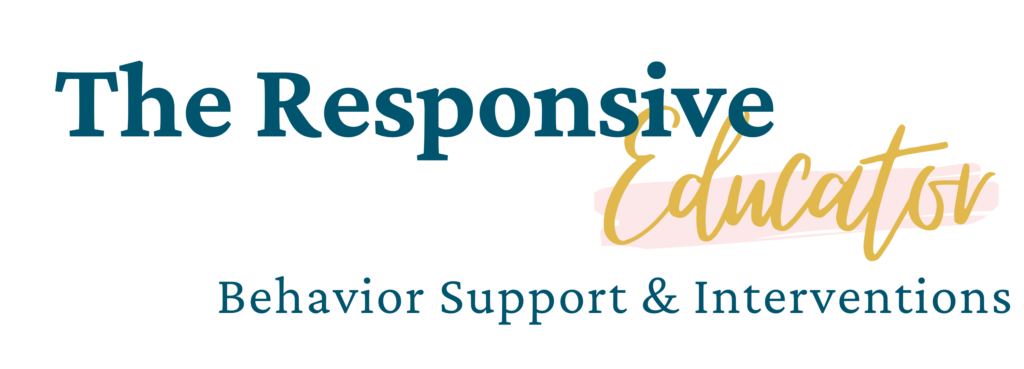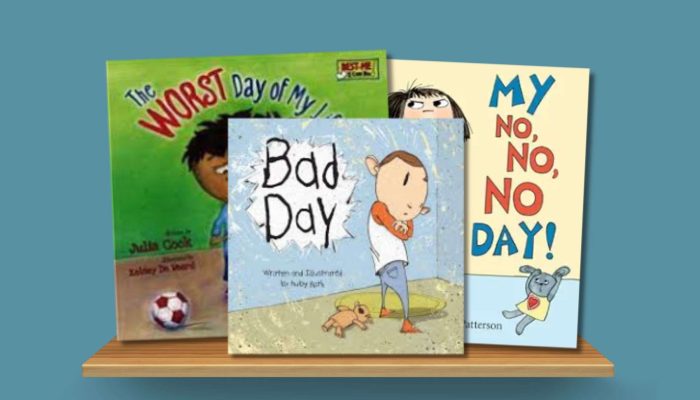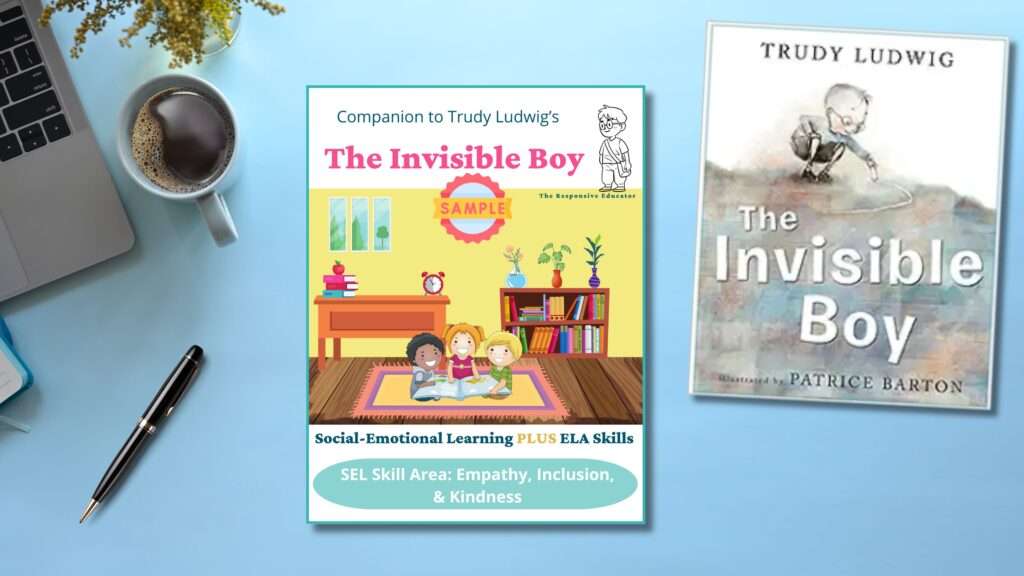


Every child has bad days where nothing seems to go right, and emotions run high. Whether it’s a rough day at school, a conflict with friends, or just feeling off, helping kids process these feelings is important for emotional growth. In this post, we’ve gathered six bad day books that offer comforting stories and helpful insights to guide children through those tough moments. These uplifting books are perfect for sparking conversations about frustration, resilience, and how to move forward after a rough day—whether at home or in the classroom.
For some of the books on this site, I’ve created interactive read-alouds designed to enrich their use in the classroom. These resources include discussion questions, activities, and prompts that actively engage students and deepen their understanding of key themes. More interactive read-alouds are on the way! If there’s a specific book you’d like to see included, please reach out using the contact form at the bottom of the page.
For more insights on supporting social-emotional learning (SEL) and incorporating interactive read-alouds into your teaching, explore these posts:
(As an Amazon affiliate, I earn a small commission if you purchase products through the links on my posts. Thank you for your support!)
Summary: Bad Day by Ruby Roth tells the story of Hennie, a little boy who is having a really tough day. From small annoyances to bigger frustrations, everything seems to be piling up, and Hennie feels overwhelmed. Needing some space to process his feelings, he takes time for himself, using deep breaths and quiet moments to reflect. Through this, Hennie learns that by turning inward and giving himself time, he can work through his emotions and find calm again.
Description: Bad Day by Ruby Roth is a thoughtful and uplifting book that offers children a way to handle overwhelming emotions. Hennie’s day starts off badly and only seems to get worse, with little things feeling bigger than they are. Through relatable moments, Roth’s story shows how taking a step back, breathing deeply, and reflecting can help children navigate their feelings and regain control. Roth’s illustrations add humor and warmth to the story, making it both engaging and reassuring for young readers.
This book is a great resource for teaching kids about mindfulness, showing them that it’s okay to have bad days, but they also have the tools to process those emotions in a healthy way.
Reviews and Considerations: Bad Day has been praised for its sensitive approach to emotional regulation and mindfulness. Parents, educators, and counselors appreciate the book’s focus on self-reflection and its empowering message of helping children recognize their own ability to handle tough emotions. By encouraging kids to take a pause and work through their feelings, Bad Day becomes a valuable tool for developing emotional resilience.
Perfect for early to mid-elementary students, this book provides children with practical strategies for handling difficult days. Its focus on self-awareness and taking control of emotions makes it a great resource for homes, classrooms, and therapy settings, guiding children toward emotional growth and resilience.

Summary: Benji, the Bad Day, and Me by Sally J. Pla tells the touching story of two brothers, one of whom is on the autism spectrum. The book follows Sammy, the neurotypical sibling, as he struggles through a rough day filled with frustration and disappointment. It often seems to Sammy that his bad days go unnoticed, especially when compared to his younger brother Benji’s.
However, by the end of the story, it’s Benji who provides unexpected comfort to Sammy. Through gentle storytelling and heartfelt illustrations, this book highlights the importance of empathy, love, and understanding within a family, especially when one sibling has different needs.
Description: This picture book is a beautiful exploration of sibling relationships, neurodiversity, and the emotional complexities that can arise when one child has autism. Benji, the Bad Day, and Me addresses both the frustrations and joys of being a sibling to a child with autism while emphasizing that all children have bad days and need support.
Sally J. Pla’s sensitive writing, coupled with Ken Min’s evocative illustrations, brings to life the delicate bond between the brothers. Benji’s quiet presence and Sammy’s realization that he is seen and understood by his brother will resonate with readers of all ages. This story is particularly powerful for families with neurodivergent children, offering a meaningful reflection on the shared emotions that connect us, no matter our differences.
Reviews and Reflections: Readers overwhelmingly praise Benji, the Bad Day, and Me for its heartfelt portrayal of sibling love and its nuanced depiction of neurodiversity. Many reviews highlight how the book captures the real emotions of living with a sibling who has autism, including the disparity in attention and expectations, without assigning blame. The book is described as “a beautiful representation of what autism looks like in real families” and celebrated for the way it “addresses the feelings of siblings” in a way that is relatable for young readers.
The book is praised for its ability to spark important conversations about fairness, patience, and understanding, both in classrooms and at home. Teachers found it valuable for classroom discussions about Autism Acceptance, while parents appreciated the story’s gentle handling of sensory overload and sibling empathy. One reader noted how it “touched my whole family,” particularly emphasizing how it addresses the challenges of dealing with sensory overload while balancing the needs of a neurotypical sibling.
In terms of considerations, some reviewers emphasized the importance of adult guidance when reading the book. The story doesn’t overtly identify Benji as being on the autism spectrum, which may require further explanation for younger readers. However, this subtlety also allows the story to focus on the shared experiences of both siblings rather than focusing solely on Benji’s autism. The story invites readers to understand the emotional lives of all children, regardless of whether they are neurodivergent or neurotypical.

Summary: My No, No, NO Day! tells the story of Bella, a young girl having a terrible day where nothing seems to go right. From getting dressed to eating dinner, Bella is filled with frustration, and her bad mood only seems to grow throughout the day. However, despite all her outbursts and negativity, Bella’s mother remains patient and loving, helping her through her rough patch. In the end, Bella is able to reflect on her day, acknowledging that sometimes bad days happen, but that love and understanding can make even the worst days more bearable.
Description: This charming and relatable picture book takes readers through the emotional highs and lows of a child’s “bad day.” Bella’s experiences, from being upset with her breakfast to her frustration at bedtime, are familiar to both children and their caregivers. The story captures the emotional rollercoaster young children often go through when nothing seems to go their way.
The humorous yet heartfelt narrative combined with the vibrant illustrations make this book a favorite for many families. Children can see themselves in Bella’s outbursts and struggles, while adults appreciate the humor and gentle reminder that patience and understanding are key when dealing with a child’s bad day. The story opens up opportunities for families to discuss how everyone has bad days and how we can recover from them with a little bit of love and care.
Reviews and Considerations: My No, No, NO Day! has been praised by both children and adults for its relatable storyline and engaging illustrations. Parents appreciate how the book mirrors the common struggles of young children, making it a favorite for ages 3-5. Many readers noted how the book helps children process emotions, especially those with Sensory Processing Disorder or Autism Spectrum Disorder, making it a useful tool for discussing difficult feelings.
The humor in the story, paired with colorful illustrations, adds a lightheartedness that keeps kids engaged, even after multiple readings. Parents also appreciated the opportunity the book provides to discuss emotions and how to recover from a bad day with love and patience. The book’s heartwarming and humorous portrayal of a challenging day resonates with children and caregivers alike, making it a valuable resource for teaching emotional awareness.

Summary: The Worst Day of My Life… Ever! follows RJ, a boy who’s having a day where nothing seems to go right. From not listening to his mom in the morning to making mistakes at school, everything RJ does seems to turn his day from bad to worse. Through RJ’s experiences, the story illustrates how failing to follow instructions can create a series of avoidable problems. In the end, RJ learns that listening and following directions can turn the worst day ever into one of the best.
Description: In this relatable story by Julia Cook, children are introduced to the consequences of not listening and the importance of following instructions through the character of RJ, who experiences a series of mishaps throughout his day. The book uses humor and engaging illustrations to teach kids how their choices affect their day and others around them. With simple rhymes and clear examples, the book is both an entertaining read and an educational tool. It is an ideal resource for parents and educators looking to teach kids about responsibility, problem-solving, and the impact of listening.
Reviews and Considerations: Readers generally appreciate The Worst Day of My Life… Ever! for its practical message about listening and making good choices. The book effectively engages younger readers with its fun illustrations and relatable plot, while teaching valuable life skills. Many parents and educators noted that the book opened the door for meaningful discussions with children about how their actions affect their day.
However, some reviewers expressed concerns about the portrayal of consequences, feeling that certain situations were exaggerated, such as being sent to the principal’s office for minor mistakes like wearing a hat indoors. They felt these moments could have been addressed more empathetically, particularly for children who may be sensitive to criticism. Despite these concerns, the book remains a popular tool for teaching children about the benefits of listening and following directions.

Summary: In Zach Gets Frustrated by William Mulcahy, Zach is having one of those days where everything seems to go wrong. It starts with him dropping his toothbrush in the toilet and only gets worse when his best friend chooses to attend another birthday party instead of joining him. By the time he reaches the beach with his family and struggles to get his kite to fly, Zach’s frustration boils over. He kicks sand, shouts angry words, and tells his dad he just wants to go home. Sensing his son’s frustration, Zach’s dad steps in to teach him a simple three-step process—Name it, Tame it, Reframe it—giving Zach the tools he needs to calm down and turn his day around.
Description: Zach Gets Frustrated is a practical teaching tool wrapped in a relatable story that offers children a simple, three-step strategy to manage frustration: “Name it, Tame it, and Reframe it.” The book is ideal for classroom or home use, especially with early elementary-aged children. It is more than just a story—it introduces children to real-life coping mechanisms for dealing with strong emotions like frustration.
The “chill skills” taught in the book—such as deep breathing and reframing thoughts—are practical techniques that can be used in various settings, making this a valuable resource for teachers, counselors, and parents alike. The book also includes additional guidance for adults to help children apply these strategies beyond the story.
Reviews and Considerations: The book has received positive feedback for its straightforward, practical advice on handling emotions like frustration. One reviewer, a professional counselor, praised the solid, age-appropriate anger management techniques presented in the book, such as deep breathing and counting to ten, making it a hit for her 7-year-old child.
Another review noted that the book’s lessons are effective for children in early elementary school, with one parent stating that their child began applying the “chill skills” from the book in real life after only a couple of readings. The clear structure of the story makes it particularly appealing for both children and adults, with one reviewer commenting that their son shared the strategies with his classmates, demonstrating the book’s accessibility.
While most readers enjoyed the story and its teachings, some raised minor concerns. One professional mentioned that Zach uses words like “stupid” and “idiotic” in frustration, which may not sit well with all parents. However, this was seen as an opportunity to teach children that people can say things they don’t mean when upset. Another reviewer found the book slightly long for younger children, suggesting it might be more suitable for kids ages 6 and up.

Summary: Alexander and the Terrible, Horrible, No Good, Very Bad Day tells the story of Alexander, a young boy whose day goes wrong from the moment he wakes up. From finding gum in his hair to facing challenges at school, Alexander encounters a series of frustrating events that make him wish he could move to Australia. As his day unfolds, Alexander learns that bad days happen to everyone—even in Australia.
Description: Written by Judith Viorst, Alexander and the Terrible, Horrible, No Good, Very Bad Day is a cherished picture book that humorously reflects the ups and downs of a child’s bad day. The story vividly captures Alexander’s growing frustration with small but relatable mishaps, from losing a toy to struggles at school. While it’s not a teaching book per se, it’s a fantastic jumping-off point for discussions about emotions, resilience, and handling tough days. Ray Cruz’s expressive illustrations add depth to the story, making Alexander’s emotions even more relatable.
Though not specifically a “how-to” book on managing emotions, Alexander and the Terrible, Horrible, No Good, Very Bad Day offers children and adults a shared space to acknowledge feelings and talk about how bad days can happen to anyone—and that they won’t last forever.
Reviews and Considerations: This timeless classic is beloved by parents, educators, and counselors alike for its humorous and authentic portrayal of a child’s tough day. The way Alexander’s frustrations build and his wish to escape to Australia provide a fun yet meaningful way to engage children in discussions about their own bad days.
While not designed as an instructional resource, the story naturally lends itself to conversations about emotional regulation, frustration, and coping with difficult moments. It’s an ideal choice for sparking dialogue at home or in the classroom, allowing children to talk about their feelings in a relatable, lighthearted manner.



Sign up now to receive a free sample of “The Invisible Boy” Interactive Read-Aloud Lesson Plan! This comprehensive resource includes engaging activities designed to help your students develop empathy and inclusion.
By signing up, you will also join our newsletter, where you’ll receive:
Join our community of educators dedicated to fostering social-emotional growth in the classroom!

( ) = Coming Soon
Body Safety & Personal Boundaries
(Conflict Resolution)
(Compromise / Cooperating)
Feelings & Emotional Awareness
(Sensory Processing)
(Sharing)
(Speaking Politely)
(Teasing & Bullying)
(Trauma Recovery)